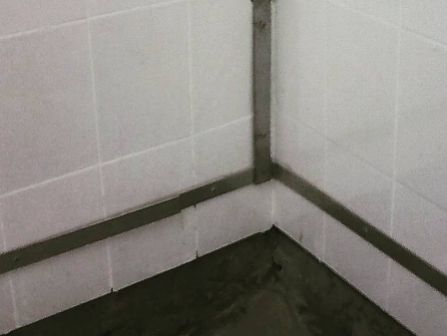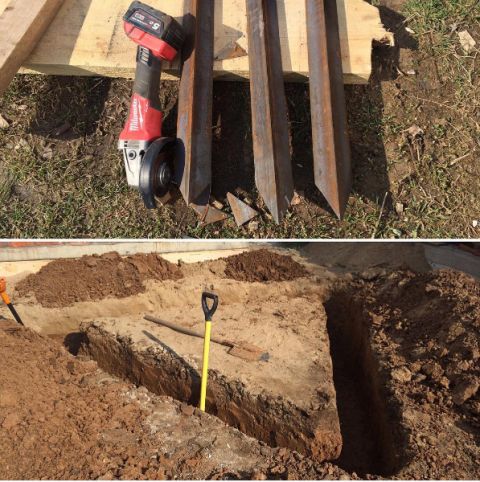Categories: Featured Articles » Sharing experience
Number of views: 16704
Comments on the article: 2
Ground home wiring, ground loop in a private house
In addition to providing reliable power to household appliances, it is very important that home wiring is safe to operate. Safety consists, first of all, in preventing electric shock. That is, home wiring should be performed in such a way as to exclude the possible impact of electric current on a person.
The main methods of protecting electrical wiring is grounding the electrical wiring, as well as the use of appropriate protective devices - residual current circuit breakers, differential machines. In this article, we will consider the question of how to ground the home wiring.
When do you need to do individual grounding?
 Before doing an individual grounding of the wiring, you need to figure out whether it is necessary at all. Often people make grounding in the house, arguing that they allegedly increase safety. In fact, an individual grounding circuit in a private house should be done if the grounding system of the electrical network does not provide sufficient security.
Before doing an individual grounding of the wiring, you need to figure out whether it is necessary at all. Often people make grounding in the house, arguing that they allegedly increase safety. In fact, an individual grounding circuit in a private house should be done if the grounding system of the electrical network does not provide sufficient security.
Usually these are networks earthing systems TN-C, TN-C-Sin unsatisfactory technical condition. An interruption of the neutral wire on the power line of networks of this configuration can lead to the appearance of a phase on the grounded housing of household electrical appliances.
In this case, it is advisable to ground the home electrical wiring by connecting to its grounding circuit, and the combined neutral and protective conductor of the electrical network should be used exclusively as a neutral wire, that is, in this case, the electrical grounding system will type TT.
If the electrical networks are in normal technical condition, or these are TN-S system networks in which the neutral and protective conductors are separated along their entire length from the power substation to the consumer, then there is no need to install an earth circuit in a private house.

Ground loop in a private house - a brief description, installation features
First, consider what a ground loop is. The ground loop in a private house is performed, as a rule, in the form of an equilateral triangle.
This type of circuit is structurally composed of horizontal and vertical earthing switches. In this case, the vertices of the triangle are vertical ground electrodes, they are driven into the ground to a depth of 2-3 m, the sides of the triangle are horizontal ground electrodes that connect the vertical ground electrodes to each other.
The distance between the vertices of the triangle - vertical ground electrodes buried in the ground is 1.2-1.5 m. It is sufficient to deepen the horizontal ground electrodes by 0.5 m. The depth to which vertical ground electrodes are clogged depends on local conditions, in particular, the type of soil and climatic conditions. The above range of 2-3 m is relevant for areas with a temperate climate, for non-rocky soil.
As grounding conductors, you can use black or galvanized steel, copper of various section profiles - round, pipe, angular or rectangular. For installation of the ground loop in a private house most often use black steel with an angular cross-sectional profile as vertical ground electrodes and steel strips as horizontal ground electrodes.
In any case, it all depends on what material is available or what is the opportunity to purchase.The main thing is to choose grounding conductors with a minimum permissible cross-section (cross-sectional area). For black steel, the cross section must be at least 100 square meters. mm, for galvanized steel - not less than 75 square meters. mm, for copper - the minimum value of 50 square meters. mm
See this topic: How to perform grounding calculation for the contour of a private residential building
The connection of horizontal and vertical ground electrodes is carried out by welding. To prevent destruction, welds are treated with an anti-corrosion compound. Grounding conductors themselves cannot be painted, since coating them with paint or an anti-corrosion compound will lead to an increase in grounding resistance relative to the ground, that is, such a grounding loop will be useless and, if necessary, will not provide a protective function.
As an alternative to welding, self-made or ready-made clamps can be used to connect grounding conductors to each other. If pipes are chosen as vertical ground electrodes, then ready-made pointed tips can be purchased that will provide easier entry of pipes into the ground. In the case of using steel with an angular profile, to facilitate clogging, it is enough to sharpen the ends of the grounding with an angle grinder.
The ground loop is connected to the main ground bus (PE bus) of the main distribution panel of the house using the ground conductor. As the grounding conductor, you can use the same steel strip that was used as horizontal grounding conductors. To do this, the strip is welded to the ground loop and brought to the shield. For ease of entry directly into the shield, a copper flexible conductor is used, which is attached to the steel rail by means of a bolted connection.
The grounding circuit is recommended to be located in close proximity to the main distribution panel of a private house.
When everything necessary for the installation of the ground loop is ready and its location has been chosen, we proceed directly to the installation.
According to the above dimensions of the circuit, we make the markup. In the case of connecting the vertical and horizontal ground electrodes with each other by welding, it is necessary to dig a trench so that it is convenient to weld the ground electrodes. It is also necessary to dig a trench for the grounding bus, which will connect the mounted circuit to the grounding bus of the distribution panel.
This article describes an example of mounting a triangular ground loop. It is also possible to carry out the ground loop by placing the ground electrodes in a row. This option is suitable if there is no required space for the installation of grounding conductors in the form of a triangle.

Checking the performance of the ground loop
A mounted ground loop will provide protection against the possible occurrence of a dangerous potential on the housing of household electrical appliances only if its resistance does not exceed the permissible values. For household networks 220/380 V, the resistance of the grounding circuit relative to the ground should be no more than 8 and 4 Ohms, respectively.
In the event that the grounding resistance is higher than this value, then in the event of a phase conductor closing on the housing of the household appliance, there will be a dangerous voltage value, that is, in this case, grounding will not reduce the potential that has arisen to a safe value.
To measure the resistance of the ground loop, special measuring kits are used. The kit consists of a device that records the value of resistance, rods that clog into the ground and connecting copper conductors.
This measuring kit is usually only available to those who, by the nature of their activities, often have to deal with earth resistance tests. That is, such a kit can be found at a friend of the power engineers and take measurements yourself or use the corresponding service from electricians performing electrical work.
In order to be sure of the performance of the grounding of the home electrical wiring, do not neglect the ground resistance test. It is also recommended that this check be done every 6 years. If there is a noticeable increase in ground resistance compared to previous measurements, this indicates that the ground loop is destroyed, possibly the integrity of the welds. In this case, it is necessary to check it and, if necessary, repair the damage.
If it is not possible to check the ground loop using a special measuring kit, then you can check the grounding performance in an alternative way using a multimeter or a conventional incandescent lamp.
After connecting the mounted ground loop to the ground bus in the home switchboard, you need to take an indicator screwdriver, find the phase terminal in the outlet, then take the multimeter, set it to the AC voltage measurement limit and measure the voltage value between the phase conductor and the grounding terminal of the outlet.
If the voltage between the phase and ground conductor is approximately equal to the voltage between phase and operating zero, then this indicates that the ground loop is operational.
In the event that the voltage is much lower than the mains voltage, it means that the ground loop has a high resistance exceeding the permissible value.
Similarly with an incandescent lamp - the level of luminescence of the lamp, you can determine the performance of the ground loop. If the lamp connected between the phase and protective conductors of the outlet is dim, this indicates that the ground resistance is higher than the permissible value. Full-lamp burning indicates that the ground loop is operational.
The increased resistance of the mounted grounding device indicates that the area of the grounding circuit is lower than the required values, insufficient depth of penetration of the vertical grounding conductors, or poor contact between the grounding conductors or the grounding conductor.
If the resistance test of the grounding circuit was not carried out or was carried out incorrectly, then in the future the inoperability of the installed grounding circuit can be manifested by tingling during operation of household electrical appliances that have insulation violations with respect to the housing.
In conclusion, it should be noted that protective grounding cannot provide complete protection against electric shock in the event of a hazardous potential on the equipment case. Therefore, as additional protection against electric shock, as mentioned above, it is imperative to install a residual current circuit breaker or a difavtomat in the electrical distribution panel. It is also recommended to install a voltage relay, which will protect the wiring from voltage surges, as well as the negative consequences of a zero wire break.
See also at bgv.electricianexp.com
:
